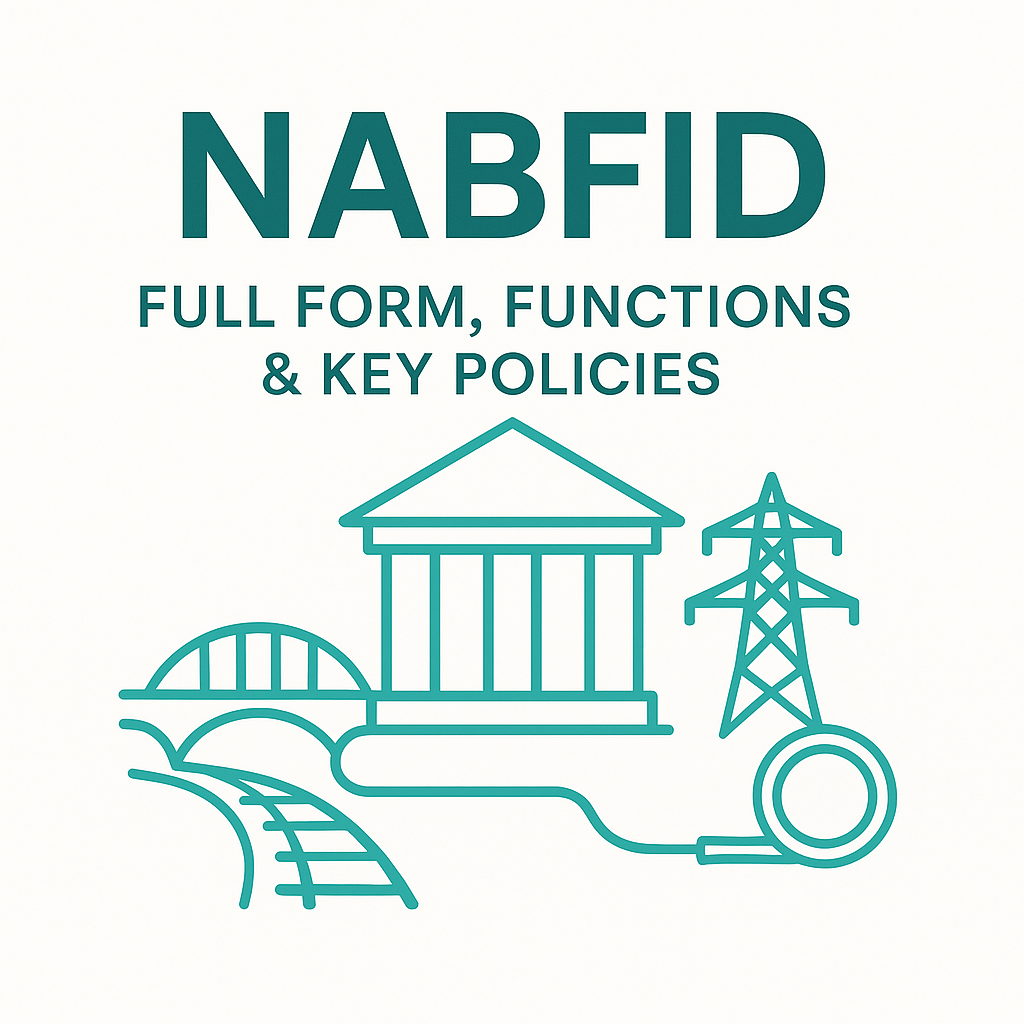India’s ambitions to become a $5-trillion economy rest on steady bridges, clean energy, and speedy data pipes. Conventional bankers are reluctant to finance projects that tie up capital for decades. To bridge this gap, the Government of India established a new development-finance machine in 2021: the National Bank for Financing Infrastructure and Development, or NABFID. Since inception, the bank has floated AAA-rated bonds, inched into international partnerships, and broken the trillion-rupee sanctions barrier—all indicators that long-term infrastructure capital is finally picking up momentum.

NABFID Full Form
NABFID is short for National Bank for Financing Infrastructure and Development. Established under the NABFID Act 2021 and governed by the Reserve Bank of India, the bank is a specialized Development Financial Institution (DFI). Its one-point objective is to mobilise patient, low-cost finance for roads, rails, renewable energy, urban transit, and digital networks—infrastructure projects that support inclusive growth in India.
NABFID Functions and Significance for the Economy
Long-term Lending
NABFID provides 20‑ to 30‑year loans at competitive terms, a tenor commercial banks seldom match. This funding window of stability enables project developers to schedule build‑out phases without fear of sudden refinancing.
Market Deepening
By issuing high‑grade bonds of various tenors—its first five‑year tranche in April 2025 among them—the bank expands India’s corporate debt market and offers new investment opportunities for pension and insurance funds.
Credit Enhancement
With its Partial Credit Enhancement (PCE) facility, NABFID underwrites as much as 20 percent of the value of an infrastructure bond, which enhances the rating of the bond and reduces investors’ required coupon. The bank has applied for permission to lift the cap to 50 percent, which will further minimize the cost of borrowing for projects.
Catalyst for Private Capital
Recent memoranda with institutions like the New Development Bank offer co‑financing in clean energy and green transportation, injecting foreign know-how and lower-cost funds into India’s infrastructure pipeline.
Macroeconomic Significance
Each rupee of expenditure on basic infrastructure generates several rupees for GDP in construction activity, logistics cost savings, and technology spill‑overs. By mobilizing patient capital, NABFID reduces pressure on government budgets and brings forward India’s timeline to meet net‑zero targets.
Most Significant NABFID Policies (Summarized in Paragraphs)
April 2025 | First Five-Year Bond Issue
NABFID accessed the market in April 2025 for ₹80 billion through five-year bonds—its most recent, shortest tenor. The operation widened its base of investors and indicated faith in the bank’s credit profile and made subsequent issuances more liquid and appealing.
April 2025 | MoU with New Development Bank
The same month, NABFID entered into a Memorandum of Understanding with the New Development Bank. The MoU structures collective financing for renewable energy, metro rail, and social‑impact infrastructure, establishing NABFID as India’s portal to multilateral climate finance.
2024 | Partial Credit Enhancement Facility
Realising that private investment is usually held up by high coupon rates, NABFID brought in a Partial Credit Enhancement facility with a ceiling of 20 percent of bond size. The bank has already approached the Reserve Bank of India to raise this ceiling to 50 percent, a policy adjustment that can reduce interest expenses and hasten project closures.
FY 2025 | ₹530 Billion Debt‑Raise Plan
For the financial year ending March 2025, NABFID aims to raise ₹530 billion from domestic and overseas debt markets. The strategy is in line with its aim of sanctioning ₹1 trillion in new projects each year, giving contractors and equipment suppliers a stable pipeline.
2023 | ₹1 Trillion Lending Milestone
In only 15 months of full operations, NABFID approved loans of over ₹1 trillion. This initial achievement proved the bank’s implementation capability and allayed stakeholders that India’s infrastructure financing snag could be overcome with concentrated institutional facilitation.
Conclusion
The full form of NABFID—National Bank for Financing Infrastructure and Development—indicates India’s determination to construct quicker, cleaner, and smarter. By providing long‑term loans, strengthening bond markets, and implementing forward‑looking NABFID initiatives like partial credit enhancement and green‑finance tie‑ups, the bank reduces the cost of capital for roads, rails, power transmission, and digital networks. These initiatives generate employment in the present and increase productivity over decades, benefitting the overall economy—education, healthcare, and industry. For investors, policymakers, and companies monitoring growth hotspots, keeping current with NABFID policies provides a clear lens into where the next wave of infrastructure—and opportunity—will emerge.
ixamBee specializes in providing expert guidance and resources for banking exams 2025, ensuring that you are well-prepared for the Upcoming Bank Exams like RBI Grade B, NABARD Grade B, IBPS SO, and more. Our courses align with the bank exam calendar 2024, covering all the essential topics. With a focus on the upcoming bank jobs, our Previous Year Papers, BeePedia, SSC CGL, SSC CHSL, SSC MTS and other Mock Tests are designed to help you excel in upcoming banking exams.















